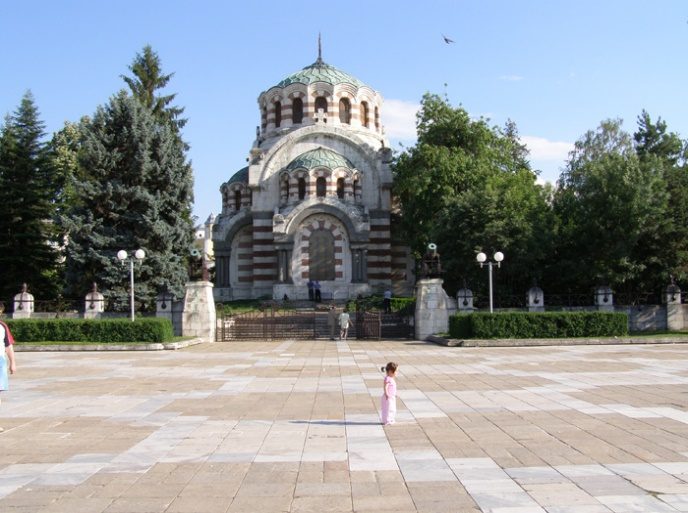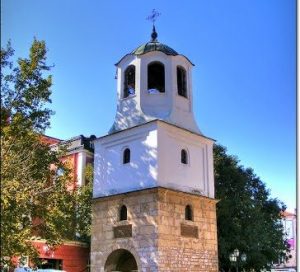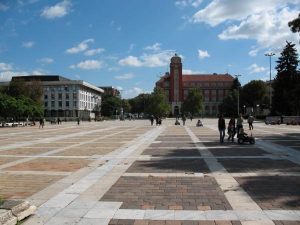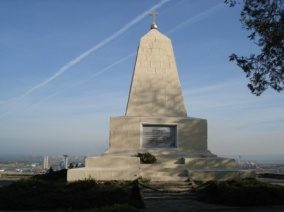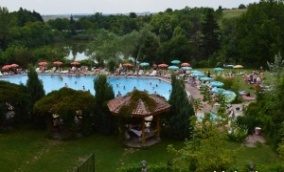

The Mausoleum – Chapel “Saint George” was built in the period 1903 – 1907, in the memory of the Russian and Romanian soldiers who fell in the battles from near Pleven during the times of the Russian – Turkish war 1877/1878. The construction proposal is presented to the czar Alexander the IInd the Liberator on the 18th of May 1902 at the end of the same year, he gave the start of a national contest which involved 12 Bulgarian architects. On the 23rd of March of the year 1903 the winner was declared – the Architect Pencho Koychev. The building is monumental, a monument of gratitude, it was built in the style of the Bulgarian church.
On the 24th of April of the year 1903, the general – lieutenant Danail Nikolaev, Yuri Bahmetiev – a Russian diplomatic agent and N. Mishu – the plenipotentiary Romanian minister, Dr. Stoyan Danev – the Prime Minister, the colonel Mihail Savov – the Minister of Defense and Dragan Tsankov – the President of the National Gathering, have solemnly set the foundation stone of the mausoleum – chapel. For its construction there were spent approximately 300 000 golden lev. A significant part from these funds was collected through the voluntary contributions from the municipalities, counties and from the people from the entire country. The mausoleum from Pleven is a remarkable historical and architectural monument.
The mausoleum from Pleven is a remarkable historical and architectural monument. Its image portrays the most daring figures of the Renaissance masters. The elements of the church in a Bulgarian – Byzantine style give a solemn greatness and splendor. The mausoleum has a central chapel and four laterals. The central dome is of 24 meters height and it ends with a steel cross. At north and in the southern part of the Mausoleum there are placed the great memoirs with the names of the Russian and of the Romanian troops, with the officers and with the number of the soldiers killed in Pleven. Up, on the corners with bronze letters there are marked cities, villages and battle fields on which there took place the most ardent and the most decisive battles: Pleven, Shipka, Stara Zagora, Plovdiv, Shejnovo, Gorni Dubnik, Grivița and others.
At the scheme there participate the prof. Mituri Zheko Spiridonov, prof. Marin Vasilev, prof. Ivan Travnitski, Boris Mihailov, prof. Ivan Markvichka, prof. Anton.
The unique interior is the credit of the sculptors and of the painters, most of the teachers from the Drawing School Sofia, today the Academy of Arts. The sculpture of Saint George, which is situated above the entrance door from the museum, it is the work of the famous Bulgarian sculptor Zheko Spiridonov. Only from a certain angle there can be seen the unique idea of the author – on the forehead on the dragon it is placed the Turkish crescent and the spear tip of the saint – the Cross.
The cherubs in the room are executed by another great Bulgarian sculptor – Marin Vasilev, who is the author of the monument of Vasil Levski from Karlovo. The mural paintings have been executed 30 years ago and they were made by Ivan Kozhuharov. Unique is the iconostasis. It is a sculpture of golden linden tree wood, the work of Jan Travnichka. A curious fact is the fact that, right before the iconostasis was installed in 1906, it received a golden medal at the World Fair from Paris. The icons were painted by two great artists of that time – Anton MITOV and Ivan Marvichka. They don’t follow the church canons, and they make a real painting. Rarely there can be seen in the Bulgarian church Saint George who isn’t on the horse and an image of the Russian saint Alexander Nevsky. The opulent chandelier has been recently donated by the famous family from Pleven, Diakovski. The door from the front of the mausoleum is decorated with bows in the popular Bulgarian style. On the northern and on the southern wall from the house of the temple in 1959, there were placed two copies of the painting of the great battles, belonging to the Russian artist VV Vereshchagin, a war participant – “Before the attack” and the “Memorial service”. A narrow staircase goes down the charnel house. In the charnel house there are two plates: on the western side, with a text by Stoyan Zaimov, about the heroism and the sacrifice of the Russian soldiers who shed blood for the freedom and with the gratitude of our Bulgarian people, and of a group of cadets from the Corp of Cadets from Odessa, who visited the Mausoleum in 1910. In the crypt of the chapel in three sarcophagi there are the bones of the soldiers who died in the battles from Pleven from the imperial Romanian army and from the Russian alloyed army. Their bones were transported in a common tomb where they were buried. The small park surrounding the Mausoleum cover 4.000 s.m. and it is planted with box, cypress, linden, ornamental shrubs and roses. The alleys are paved with motives of stones specific to the popular Bulgarian embroidery. The fence is massively built from the blocks of carved stone and decorates with seashells and cannon balls. Before this there are the weapons from the Russian siege – mortars of 6 and 8 inches. In front of the mausoleum on the central promenade there is an interesting sign of box: “Heroes, your bones gave us our freedom”.
Despite all these, the church’s services from here are made only four times per year – on the 1st of March – the day of the death of the Russian emperor Alexander the IInd, on the 3rd of March, for the titular saint – on the 6th of May and on the 10th of December – the date when Pleven gains freedom.
The Mausoleum – Chapel “Saint George” was officially opened and consecrated on the 3rd of September 1907, in the presence of Prince Ferdinand I, of the Great Duke Vladimir Alexandrovici, of the son of the emperor Alexander the IInd, of the Duchess Maria Pavlovna and of the members of the committee “the Liberator Czar Alexander the IInd”.
